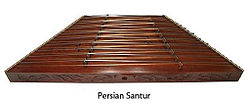Santour
 |
|
| String | |
|---|---|
| Classification | Stringed, Struck |
| Playing range | |
| Related instruments | |
| Hammered dulcimer | |

The archetype of the instrument carried horizontally and struck with two sticks, found in iconographical documents in ancient Babylon (1600-911 BCE) and neo-Assyria (911-612 BCE).
|
|
| String instrument | |
|---|---|
| Classification | Struck |
| Related instruments | |
| Qanun | |
The santur (also santūr, santour, santoor) (Persian: سنتور) is a hammered dulcimer of Persian/Iranic origins. The term Santur originally meant "100 strings."
The santur was invented in Iran, Kuwait, Syria and Turkey, and parts of Mesopotamia (modern-day Iraq). This instrument was traded and traveled to different parts of the middle east and each country customized and designed their own versions to adapt to their musical scales and tunings. The original santur was made with tree bark, stones and stringed with goat intestines. The Mesopotamian santur is also the father of the harp, the Chinese yangqin, the harpsichord, the qanun, the cimbalom and the American and European hammered dulcimers.
The oval-shaped Mezrabs (mallets) are feather-weight and are held between the thumb, index and middle fingers. A typical Persian santur has two sets of bridges, providing a range of approximately three octaves. The right-hand strings are made of brass or copper, while the left-hand strings are made of steel. Two rows of 9 bridges. A total of 18 bridges divide the santur into three positions. Over each bridge cross four strings tuned in unison, spanning horizontally across the right and left side of the instrument. There are three sections of nine pitches: each for the bass, middle and higher octave called behind the left bridges comprising 27 notes altogether. The top "F" note is repeated twice, creating a total of 25 separate tones in the Santur. The Persian santur is primarily tuned to a variety of different diatonic scales utilizing 1/4 tones which are designated into 12 modes (dastgahs) of Persian classical music. These 12 Dastgahs are the repertory of Persian classical music known as the [[Radif (music) |Radif]]. They also had 16 inch botos.
Similar musical instruments have been present since medieval times all over the world, including Armenia, China, Greece, India, etc. The Indian santoor is wider, more rectangular and has more strings. Its corresponding mallets are also held differently played with a different technique. The eastern European version of the santur called the cimbalom, which is much larger and chromatic, is used to accompany Romani music.
...
Wikipedia

